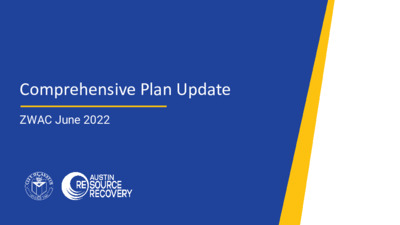ARR Comprehensive Plan Update — original pdf
Backup

Comprehensive Plan Update ZWAC June 2022 Agenda • Progress • Community Engagement • Racial Equity Tool • Goals (ZWAC) • Climate Equity Plan • Next Steps • Questions PROGRESS Survey • 1st phase: • 2nd phase: • Open 1 month (Oct-Nov 2020) • 2,800+ respondents • Open 2 months (March-June 2021) • 300+ respondents https://publicinput.com/arrsurvey Community Engagement: Survey Survey Participants: Phase I Survey Outreach MARKETING • Digital • Radio • Print • Television OUTREACH • Places of Worship • Grocery stores • Meal distribution organizations • Farmers Markets • YMCAs • COA Community Centers Survey Outreach: Timeline Survey Participants: Phase II Survey Type and Language Survey Takeaways Diversion Frequency Majority report “always” or “frequently” practicing 4 out of 5 diversion activities listed: recycling, reusing items, repairing items, donating items Knowledge of ARR Programs and Services Majority report “no knowledge” of Zero Waste Block Leader Program, and clothing and housewares curbside collection Use of ARR Programs and Services Approximately half or more respondents have used the Recycle & Reuse Drop-off Center Desire for Additional Drop-off Facilities The most desired additional drop-off option is several, smaller drop-off centers at libraries and city facilities 2nd Phase: May, July, August 2021 • 7 focus groups • Community members • 50 participants 1st Phase: July 2020 • 7 focus groups • Environmental/Non-Profit Groups • Commercial Building Managers and Event Organizers • Educational Institutions • Food Service Providers • Haulers and Solid Waste/Recycling Facilities • Multi-Family Building Managers • Reuse Community • 38 participants Focus Groups Focus Groups: Takeaways • Residents are familiar with ARR’s core curbside services • Participants suggested the need for clear, repetitive, and consistent education and messaging • Building awareness about classes, rebates, and incentive programs would likely result in increased participation • Welcome collaboration with ARR Chapters: Overview • Department Structure • Metrics & Measurement • Curbside Services • Drop Off & Pick Up Services • Community Services • Facilities & Infrastructure • Commercial Collection System • Universal Recycling • Construction & Demolition • Circular Economy • Special Events • Engagement ARR Racial Equity Tool • Began development in early FY21 • Modeled after: • City of Seattle’s Racial Equity Tool • Circular Economy Team’s draft Equity Tool • Government Alliance on Racial Equity (GARE) Racial Equity Toolkit “This ARR Racial Equity Tool provides a process and questions to guide the development, implementation and evaluation of external ARR initiatives to identify and address impacts on racial equity.” Purpose of the Tool Curbside Services Explore the option of assessing additional fees for ARR customers who repeatedly place trash in their recycling and composting carts. Community Services Research development of parking ordinance to prevent vehicles from blocking access to street sweepers. Facilities & Infrastructure Obtain support for permit approval of new transfer station. Commercial Collection System Study a commercial collection system approach with the goal of minimizing negative environmental impacts, enhancing data collection, and promoting consistency and accountability. • After ARR concludes study, conduct public stakeholder meetings centered on report findings. Universal Recycling • Address valet collection services and diversion requirements • Explore development of multifamily composting policy • Evaluate tiered URO diversion requirements • Expand organics requirements beyond food-permitted businesses Construction & Demolition • Explore change to Qualified Processor rules • Consider diversion requirements for key materials Alignment with Climate Equity Plan A. Pursue waste reduction, organics composting, and recycling to achieve a community-wide per capita disposal rate goal following adoption of the updated ARR Comprehensive Plan. B. By 2030, ensure all Austinites can access a food system that is community-driven, addresses food insecurity, prioritizes regenerative agriculture, supports dietary and health agency, promotes plant-based foods, and minimizes food waste. C. By 2030, reduce GHG emissions from institutional, commercial and government purchasing by at least 50%. D. By 2030, 40% of total vehicle miles traveled in Austin are electrified, and electric vehicle ownership is culturally, geographically, and economically diverse. Alignment with Climate Equity Plan • Expand bulk pick-up program citywide (Goal A) • Develop furniture reuse bank (Goal A) • Advise Office of Sustainability's food waste root cause analysis (Goal B) • Create sustainable purchasing guidelines through Circular Cities program (Goal C) • Expand Circular Economy Program initiatives (Goal C) • Explore alternative fuels for fleet vehicles (Goal D) Next Steps Questions